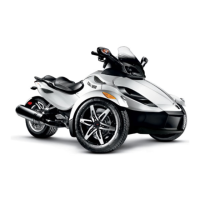BASIC PROCEDURES
Adjusting Suspension
The front and rear suspension can be
adjusted according to the load on the
vehicle or the type of ride you want to
experience.
Lower spring preload provides a softer
ride and is preferred for light loads and
smooth roads. Higher spring preload
provides a firmer ride and is recom-
mended for heavy loads, rough road
conditions and more challenging rid-
ing.
Front Suspension
WARNING
Adjust both springs to the same
load. Uneven adjustment can
cause poor handling, loss of sta-
bility and loss of control.
NOTICE
Before adjusting suspen-
sion, manually raise the front of ve-
hicle to extend the suspension. This
will ease turning the adjustment
cam and will prevent a potential
breakage of the adjustment plate.
1. Place the vehicle on a level surface.
2. Engage the parking brake.
3. Adjust the spring preload by turning
the cam with the adjusting wrench
(stored in the tool kit).
rmr2008-029-002
FRONT SUSPENSION ADJUSTING WRENCH
rmr2008-029-003
FRONT SUSPENSION CAM ADJUSTMENT
rmr2008-030-004_c
A. Smooth adjustment (position 1)
B. Hard adjustment (position 5)
RECOMMENDED FRONT SHOCK
ADJUSTMENT
LOAD
CAM
POSITION
68 kg (150 lb) rider 1, 2
91 kg (200 lb) rider 3
68 kg (150 lb) rider
with cargo
3
91 kg (200 lb) rider
with cargo
4
Rider with passenger
and cargo
5
Rear Suspension
1. Place the vehicle on a level surface.
2. Block the front wheels.
3. Install a jack under the rear portion
of frame.
NOTICE
Do not jack the vehicle un-
der the rear shock.
4. Lift the rear of vehicle until the
shock absorber is fully extended.
28
______________

